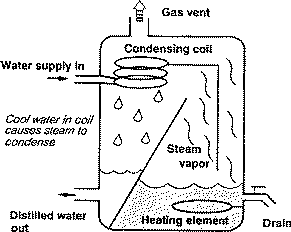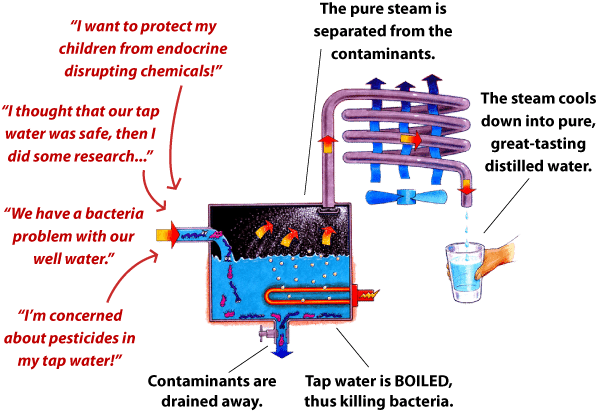The Science Of Distillation
Distillation is deceptively simple: heat a liquid until it evaporates, capture the vapor, then cool it back into liquid form to isolate a purer substance. It’s the same principle that gives us everything from sterile laboratory reagents to the smoothest spirits in a craft distillery. At its core, distillation leverages boiling point differences—water boils at 100 °C, while ethanol turns to vapor at about 78 °C—so when a mixed liquid heats up, the lower-boiling component escapes first, leaving heavier molecules behind. That steam is routed through a condenser—a coil or tube cooled by flowing water—where it relinquishes heat and reconverts into a liquid devoid of many dissolved solids, microbes, and chemicals [1].
In practical terms, if you’re purifying tap water, minerals like calcium and magnesium remain in the boiler, while the condensate is nearly pure H₂O. And if you’re capturing essential oils, each plant compound vaporizes at its own characteristic temperature: lavender’s key aroma molecules rise at around 95 °C, while rosemary’s camphor peaks at higher temperatures. By fine-tuning heat and cooling rates, artisans coax out each fraction in sequence, crafting fragrant orbs of liquid essence. I remember the first time I distilled lavender oil in my tiny apartment kitchen—steam curled through copper tubing, and the scent that emerged felt like a pocket of Provence bottled in my living room.
It’s worth noting that advanced distillers can even separate liquids whose boiling points differ by just a few degrees. Fractional distillation columns, packed with glass beads or metal rings, create multiple vapor-condense cycles within a single run, boosting purity and resolution. That’s how petrochemical refineries turn crude oil into gasoline, kerosene, and diesel, each cut collected at its own plateau of the temperature scale.
Whether you’re experimenting with a countertop water distiller or designing a mini still for botanical extracts, understanding this cycle of heating, vaporization, and condensation is the key to success. For tips on setting up efficient home units, explore our guide on distilled water systems.
Navigating Legal Considerations For Home Distillation
Anyone who’s ever Googled “how to make a still” quickly learns there’s a legal tightrope to walk. While distilling water or extracting essential oils is almost universally permitted, turning fermented mash into drinking alcohol—well, that’s another story. In the United States, federal law mandates a permit from the Alcohol and Tobacco Tax and Trade Bureau for any spirits production, even if it’s just a backyard hobby. Then add state-by-state variances: some contexts allow up to 100 gallons a year for personal use; others ban home distillation outright [1]. I once met a home brewer who’d roughed in a still base under his shed only to dismantle it weeks later when a neighbor tipped him off that local ordinances considered it “unlicensed manufacturing.” He was relieved he never fired up the boiler, though a bit deflated about shelving his oak-aged rum experiment.
If you’re focused on water purification or fragrant essences, the regs are far friendlier. Most countries view those activities as harmless, and you’ll find ready guidance on safe practices in online communities or from distillation equipment suppliers. But even then, safety protocols often mirror industrial standards: food-grade components, proper ventilation to avoid pressure build-up, and rigorous cleaning regimens to stave off microbial growth in damp tubing. Skimping on these details might not earn you a fine, but it can ruin a batch or introduce unwanted microbes that leave spoilage off-flavors.
Ultimately, before buying or building any still, do your homework: check federal statutes, state or provincial rules, and local zoning bylaws. Whether you ask a county clerk or an online legal forum, confirming you’re in the clear will save you headaches down the road—and let you focus on the fun part: crafting your first distilled masterpiece.
Pot Stills Vs Reflux Columns
Deciding between a pot still and a reflux column boils down to choosing character or clarity in every sip. Pot stills are beloved for preserving the full spectrum of flavor compounds, delivering warm, textured spirits that echo the soul of the original mash. Their simple boiler-and-condenser architecture makes them approachable: you fill the boiler, apply heat, and collect distillate. Each batch yields congeners and esters that carry depth—be it the smoky hint of peat in Scotch or the honeyed sweetness of Caribbean rum—but it often takes two or three passes to reach higher alcohol strength [2].

I remember starting with a cozy little pot still, marveling at each amber drip that carried a whisper of barrel and grain. Then I tried a column unit, and my jaw dropped when the distillate came out absolutely clear—like bottled ice. Each approach has its aficionados: pot stills for artisanal character, columns for laboratory-style consistency. Your choice will shape the aroma and mouthfeel of every batch you create.
Building Your Own Still Vs Buying Commercial Equipment
When it comes to assembling a distillation setup, the question often boils down to pride-of-craft versus plug-and-play convenience. Building from scratch can feel like the ultimate DIY weekend project: copper tubing cut to your specs, a stainless-steel pot welded or sealed, custom temperature gauges—every piece reflects your personal touch. You might snag materials from local suppliers, save a pile of cash, and learn engineering basics in the process. But don’t underestimate the frustration of chasing elusive leaks or calibrating homemade seals. One loose joint and that gleaming DIY rig can transform into a steam-spraying menace, wasting ingredients and testing your patience [1].

On the flip side, commercial distillation units—from tabletop mini stills to larger electric systems—bundle safety and reliability. They arrive with factory-tested seals, integrated safety valves, and intuitive control panels that regulate heat and flow. Yes, the price tag can be steeper—hundreds to thousands of dollars—but you gain peace of mind: warranties, clear instructions, and customer support if something goes awry. For anyone distilling daily water or experimenting with essential oils, this hassle-free experience often justifies the investment [2].
When I weighed pros and cons back in my student days—dreaming of oak-aged whiskey but armed only with a soldering iron—I opted for a beginner’s tabletop unit. No leaks, no legal worries, just a steady stream of distilled water for my chemistry experiments. If your priority is pure, reliable output without late-night troubleshooting, I recommend exploring ready-made options rather than reinventing the wheel.
Essential Components Of A Home Distillation System
In a home distillation system, every part has a job that keeps your final product pure and safe.
The boiler or boiling vessel is where it all starts. Choose food-grade stainless steel with thick walls to ensure even heating and durable handles to prevent hot-spot burnouts. Clear volume markings inside help you track batch sizes, while corrosion-resistant materials lock out contaminants from the outset [2].
The condenser is the unsung hero. Commonly built as a Liebig coil or shell-and-tube design, it uses cool water jackets to recapture vapor with over 90 percent efficiency. A leaky or undersized condenser wastes vapor—literally money—and can stall your run mid-batch. I’ve learned the hard way that a reliable condenser means uninterrupted collection and consistent proof readings.
For greater control, a fractionating column packed with copper or stainless-steel rings multiplies distillation stages within a single apparatus. Each ring acts like a mini-distiller, condensing then revaporizing liquid to elevate purity. Hobbyists marvel when a packed column upgrades a run from 60 percent to nearly 95 percent ABV in one continuous flow [3].
Never skimp on safety features: pressure relief valves, high-temperature seals, and reliable thermometers are essential. A blocked valve or unmonitored gauge can transform a tranquil hobby into a hazardous pressure cooker. For those focusing on water turning, a turnkey distillation system with detachable parts and quick-release fittings streamlines both operation and cleanup. If you’re curious, check out our guide on distilled water for healthy living for product recommendations and maintenance tips.
Important Safety Tips For Operating A Home Distillation System
Distilling at home can be thrilling, but it demands respect for temperature and pressure. A sealed system without a dependable pressure-relief valve is a ticking time bomb—always install a gauge and valve rated above your expected operating pressure [3] [4].
Material choice matters: food-grade stainless steel and high-grade copper resist corrosion and heat far better than plastic or low-spec alloys. Copper adds positive flavor notes in spirit runs but must be polished and rinsed to avoid greenish oxidation and metallic off-flavors. Never allow your condenser to run dry—constant cooling water stops steam from building pressure dangerously behind the scenes.
Wear heat-resistant gloves, keep flammable materials at a safe distance, and never leave an active still unattended. A momentary distraction can let temperatures spike or seals fail, creating leaks or worse. Treat your setup with the same vigilance you’d afford a laboratory apparatus, and you’ll keep your batches—and your home—safe.
Optimizing Distillation Techniques For Specific Products
Every drop tells a story: whether you crave crystal-clear water or a spirit bursting with character, the right still unlocks its true potential.
Pot stills excel at preserving the robust tapestry of congeners that give whiskey or rum their soulful depth. By running at a gentle pace and listening to temperature cues, distillers capture aromatic compounds without burning off delicate esters. For first-time users, I recommend a slow ramp-up in heat and tasting early fractions to judge when flavors shift.
Reflux columns shine when your goal is neutral spirits or potent tinctures. The key is managing reflux ratio—the balance between vapor returned to the column and liquid collected. Higher ratios yield purer outputs, so adjust coolant flow or column packing density to tweak your ABV targets, often in one seamless run.

For pure drinking water, electric distillers with automatic temperature controls and vacuum assistance pump out gallons overnight, stripping away minerals, bacteria, and heavy metals. I found pairing a mild vacuum with my mini still shaved off nearly two hours per gallon, letting me wake up to fresh demineralized water for my morning coffee. If you’re focused on hydration and health, explore our recommendations for distilled water systems.
Advanced Infusion And Proof Adjustment For Flavorful Spirits
Unlock bar-worthy spirits by mastering infusion and proofing. Start with a crystal-clean base: pot still runs deliver fuller bodies ideal for bold infusions, while column distillates provide a neutral canvas for subtle botanicals [3]. Warm maceration—holding botanicals at 40–60 °C—coaxes out bright, lively citrus notes, while vapor infusion through a gentle steam bath teases out floral and herbal essences.
Once your flavors bloom, proofing is crucial. Diluting to 90–110 proof with mineral-free distilled water preserves clarity and mouthfeel—any leftover minerals can dull the vibrancy you’ve painstakingly extracted. After blending, a 48–72-hour rest allows flavors to meld into a harmonious whole. I once infused vodka with strawberries and black pepper, then let it rest just a day too short; the rush of pepper overwhelmed the fruit. Lesson learned: patience pays off in balance.
Mastering Home Distillation: Key Takeaways
Home distillation is a journey through physics, chemistry, and craftsmanship—each still you choose, component you tweak, and infusion you attempt adds a chapter to your personal narrative. Whether your mission is pure water for health, fragrant essential oils, or artisanal spirits, the fundamentals remain the same: respect the laws of heat and vapor, prioritize safety, and let curiosity guide experimentation. I encourage you to sketch your process flow, plan for contingencies, and above all, enjoy the alchemy of watching liquid turn to steam and back again.
Citations
- [1] Wikipedia – Distillation
- [2] MicetCraft – How to Choose Distillation Equipment Suitable for Home Use
- [3] ACestills – Choosing the Best Distilling Equipment: A Comprehensive Guide
- [4] Freshwater Systems – What Is a Water Distiller and How Does It Work
- [5] Homebrewing.org – Home Distilling Equipment Collection
“`html
Complete Top Picks Comparison – 20 Products
| Product | Source | Price | Rating | Image | Buy |
|---|---|---|---|---|---|
| DIY Distillation Equipment Home Distiller Glassware Kit for Distilling Alcohol and Making Pure Essential Oils Chemistry Lab High Borosilicate Glass with Heat Resistance Safe Durable Experimental | Amazon | $57.00 | ★★★★★ |  | Buy on Amazon |
| QWORK 12 Pieces 100 ML Home Distillation Apparatus Set – to Making Essential Oil, Moonshine, Alcohol Distiller, Chemistry Glass Distilling, Lab Glassware Kit | Amazon | $29.97 | ★★★★☆ |  | Buy on Amazon |
| VEVOR Water Distiller, 1.1 Gal Distilled Water Machine, 750W Pure Water Distilling w/BPA Free Plastic Container, Water Distillation Kit w/Button, Countertop Distilled Water Maker for Home, White | Amazon | $65.67 | ★★★★☆ |  | Buy on Amazon |
| LETIME 3L Essential Oil Distiller, Stainless Steel Steam Distillation Kit Making Essential Oil and Hydrosol, Floral Water Machine, LT3000 Distiller Kit | Amazon | $269.99 | ★★★★☆ |  | Buy on Amazon |
| Home Distiller Distilling to Making Your Own Essential Oil, Moonshine, Alcohol Distiller Chemistry Lab Glassware Kit,Glass Distilling,Distillation Apparatus 10pcs Set, 100 ML | Amazon | $39.90 | ★★★★☆ |  | Buy on Amazon |
| 500ml Lab Distillation Apparatus, Essential Oil Separator Lab Glassware Full Kit, Water Distiller Purifie w/Condenser Tube&Funnel Steaming Glassware Equipment for Home School Lab Clear | Amazon | $44.99 | ★★★★★ |  | Buy on Amazon |
| LETIME Hydrosol Maker, Steam Distillation Equipment for Making Hydrosol and Essential Oil, KD5 Stainless Steel Hydrosol Distiller, Plug and Play Distillation Kit, Portable Hydrosol Machine | Amazon | $159.99 | ★★★★★ |  | Buy on Amazon |
| Essential Oil Distillation Kit – 500ml Distillation Apparatus Water Distiller 3.3 Boro Lab Glassware Distillation Kit with 24/40 Joint, 31pcs Set | Amazon | $75.99 | ★★★★★ |  | Buy on Amazon |
| VEVOR Alcohol Still, 3 Gallon, Stainless Steel Alcohol Distiller with Copper Tube & Build-in Thermometer & Water Pump, Double Thumper Keg Home Brewing Kit, for DIY Whiskey Wine Brandy | Amazon | $79.94 | ★★★★☆ |  | Buy on Amazon |
| Alcohol Infusion Kit for Infusing Whiskey, Gin, Vodka, Tequila, Rum – DIY Your Own Flavored Spirits with Natural Ingredients – Anniversary, Birthday Gift for Men, Husband | Amazon | $59.99 | ★★★★★ |  | Buy on Amazon |
| ZHIO Magnesium Alloy Children’s Bike 20 Inch Mountain Bike Pedal Bike 7-9-11 Years Old Boys And Girls Bike Bike Bicycle | AliExpress | $141.16 | ★★★★★ |  | Buy on AliExpress |
| Carbon Fiber Road Bike 24 Speed Oil Disc Student Road Bike Wind Breaking Racing Bike Dual Disc Brake Competition Bicycle 700C F1 | AliExpress | $1125.09 | ★★★★★ |  | Buy on AliExpress |
| Multiple Sizes Children Bike Boys Girls Toddler Bicycle Adjustable Height Kid Bicycle with Detachable Basket for 2-7 Years Old | AliExpress | $89.73 | ★★★★☆ |  | Buy on AliExpress |
| EUROBIKE carbon bicycle F1 Wheeltop EDS TX wireless 24 speed racing bikes | AliExpress | $1068.56 | N/A |  | Buy on AliExpress |
| Sport Face Mask Activated Carbon Filter Riding Mouth Cover PM 2.5 Dustproof Reusable Washable Cardio Sports Mask Cubre Bocas | AliExpress | $4.30 | ★★★★☆ |  | Buy on AliExpress |
| Wholesale 21-Speed MTB Bicycle with Carbon Steel Frame Disc Brake 24/26 Inch High Configuration Mountain Bike Ordinary Pedal | AliExpress | $281.20 | N/A |  | Buy on AliExpress |
| ROCKBROS Bicycle Inner Tube 700C Road Bike Tube 700*23C 25C 28C 35C Schrader Presta Valve Butyl Rubber Cycling Inner Tube | AliExpress | $7.56 | ★★★★★ |  | Buy on AliExpress |
| Road Commuter Bike – Muscle Aluminum Alloy Frame Fixed Gear Bicycle for Students & Adults | AliExpress | $219.85 | N/A |  | Buy on AliExpress |
| XOSS New G2 GPS Cycling Computer G Plus Wireless Speedometer Bluetooth Tracker Waterproof Road Bike MTB Bicycle Odometer | AliExpress | $23.98 | ★★★★★ |  | Buy on AliExpress |
| SAVA AEROX SLR8 Full Carbon Fiber Electronic Shift Road Bike Racing Road Bike 7.3kg with SHIMANO ULTEGRA 8170 Di2 Kit. | AliExpress | $3003.19 | N/A |  | Buy on AliExpress |
“`

